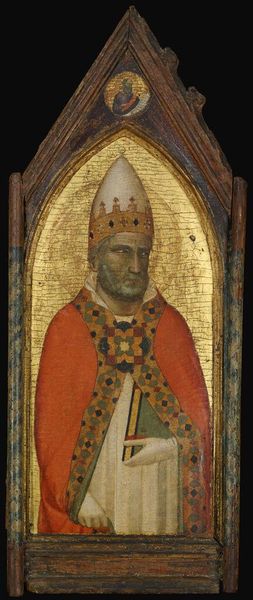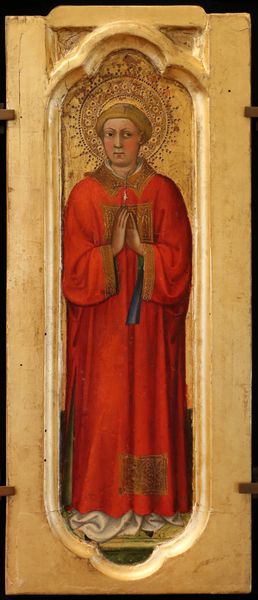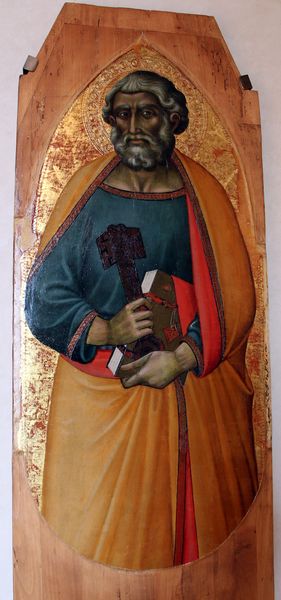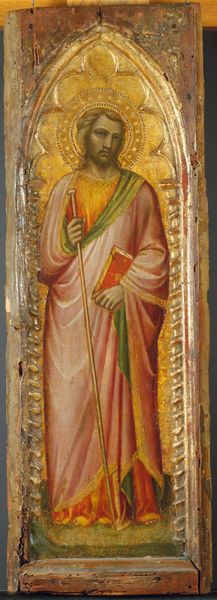
tempera, painting
#
portrait
#
tempera
#
painting
#
sculpture
#
underpainting
#
academic-art
#
italian-renaissance
#
statue
Dimensions: 21 5/8 x 12 in. (54.93 x 30.48 cm) (image)21 5/8 x 12 9/16 x 1 1/4 in. (54.93 x 31.91 x 3.18 cm) (panel)
Copyright: Public Domain
Curator: What an imposing figure. Before us is Vincenzo Foppa’s “Saint Sirus,” painted around 1460, now residing here at the Minneapolis Institute of Art. Editor: Imposing is right. I’m immediately struck by the texture – all that gold leaf against what looks like, from here, very densely worked tempera. You can almost feel the weight of those fabrics. Curator: The tempera, certainly, lends a unique texture, a certain granular quality when juxtaposed against the gilded backdrop. And precisely the application of gold suggests an emphasis on symbolic depth, almost negating dimensionality. Foppa expertly manipulated these inherent properties to create a composition where form and content reinforce one another. Editor: Absolutely. Considering the labor required for gilding and the grinding of pigments for tempera, one thinks about the social structures necessary to enable this production, the artists training, the workshop itself – who paid, who labored, and to what end? Was this pure commission, or artistic passion? Curator: Fascinating point. His expression evokes a certain inward contemplation. Note the subtle sfumato effect around his eyes and mouth—it conveys an intense intellectual and spiritual life through delicate tonal variations. The linear precision elsewhere balances the emotional nuance, forming a study in contrasts. Editor: Though a portrait of religious authority, this does remind me of other examples of Italian workshops in which different stages of the work were often delegated according to skill, specialization and the demands of patronage at the time. Look at the textures, from fabric to skin to that polished gold. Curator: Yes, by focusing on the interplay between idealized representation and realistic details Foppa transforms what could be merely an ecclesiastical portrait into something psychologically profound. Editor: Ultimately, I think this highlights not just Foppa’s artistic choices, but a broader picture about craft, economy, and Renaissance ideals of artistry within religious context. Curator: A powerful reminder that appreciating visual experience involves an appreciation of not only what we perceive, but how we perceive and how it challenges our way of understanding the subject in light of everything it suggests.
Comments
minneapolisinstituteofart about 2 years ago
⋮
During the Renaissance, altarpieces commonly portrayed biblical scenes, such as Madonna and Child, examples of which are in this gallery. These two paintings, Saint Sirus and Saint Paul, were likely part of a larger altarpiece made up of many panels, called a polyptych. The presence of a saint on an altarpiece could have a number of meanings. The saint could be the patron saint of the church or city that housed the altarpiece, for example. The key to identifying saints is to look closely at the attributes shown with them. Saint Sirus wears a mitre, the pointed headpiece, and holds a crozier, or ceremonial staff. These attributes indicate Saint Sirus was a bishop. Saint Paul is shown with his usual physical characteristics-receding hairline and long, brown beard; he is also holding a sword, his personal attribute.
Join the conversation
Join millions of artists and users on Artera today and experience the ultimate creative platform.













